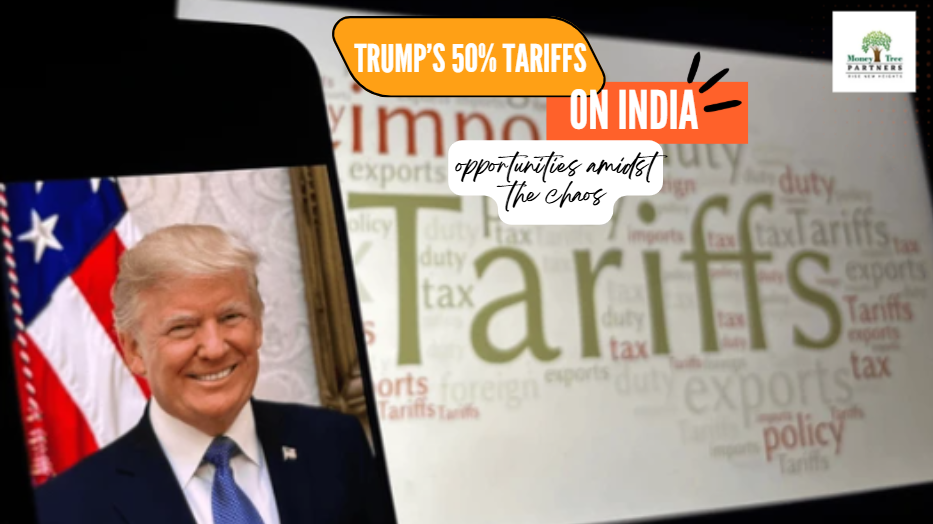
In an unexpected development in August 2025, U.S. President Donald Trump imposed a 50% tariff on a broad range of Indian imports—double the previous rate—focusing on commodities such as textiles, gems, auto parts, and others. This action, widely interpreted as a reaction to India’s ongoing acquisition of Russian oil, has created a cloud of uncertainty over India’s export sectors and financial markets. Nevertheless, for mutual fund investors in India, there may be opportunities amidst the chaos. Let us explore the implications of this situation and how astute investors can take advantage of it.
What’s Happening and Why It Matters
Trump’s tariffs—merging an earlier 25% rate with an additional 25%—are expected to be implemented in late August. Sectors heavily reliant on exports, including automobiles, textiles, jewelry, and pharmaceuticals, are likely to experience increased pressure.
Financial analysts caution that there could be a potential slowdown in GDP growth ranging from 0.3% to 0.8%, contingent on the duration of the trade conflict.
These events have led to temporary declines in the stock market, accompanied by cautious investor sentiment and slight outflows. Export-oriented mutual fund schemes are under close scrutiny.
Positive Aspects for Indian Mutual Fund Investors
1. Transition to Domestic Consumption Funds
As exports diminish in competitiveness, attention turns to sectors driven by domestic consumption. Funds that concentrate on fast-moving consumer goods (FMCG), healthcare, and financial services are likely to gain from heightened domestic demand.
2. Opportunities for Diversification
Market instability promotes diversification. Investors may shift towards balanced or hybrid funds that combine equities with fixed income, which can help reduce volatility and sustain consistent growth prospects.
3. Favorable Buying Opportunities
Market volatility frequently creates long-term buying prospects. Reduced valuations in underperforming export-related stocks may enable equity-focused mutual funds with diversified portfolios to acquire quality assets at lower prices.
4. Government Response and Economic Resilience
The Indian government and the Reserve Bank of India (RBI) continue to demonstrate confidence in the economy. Prime Minister Modi’s commitment to safeguarding sectors such as agriculture, along with the RBI’s neutral policy approach and sustained GDP growth forecast of 6.5%, underscore institutional resilience.
4 Ways Investors Should Respond
Prioritize Domestic-Focused Funds – Consider reallocating investments towards mutual funds that are focused on sectors such as consumer goods, infrastructure, and domestic banking.
Increase Allocation to Hybrid and Balanced Funds – These funds combine equities with fixed income, providing stability during fluctuations in the equity market.
Maintain Investment During Volatility – Systematic Investment Plans (SIPs) continue to provide advantages such as rupee cost averaging. Market corrections can present ideal opportunities for long-term investments.
Monitor Geopolitical and Policy Changes – Trade negotiations or policy adjustments could swiftly alter market conditions. Staying informed is essential.
Conclusion
The abrupt implementation of a 50% tariff by the U.S. on Indian products is certainly a setback for export-driven industries and may affect GDP growth in the short term. Nevertheless, this situation also offers strategic opportunities for Indian mutual fund investors. A transition towards sectors focused on domestic markets, diversification through hybrid funds, disciplined SIP investments, and a strong macroeconomic environment can mitigate the adverse effects.
Although obstacles are on the horizon, astute and well-informed investors can leverage this opportunity to rebalance their portfolios, take advantage of market corrections, and maintain resilience amidst global trade tensions. Over the long term, India’s strong domestic economy and strategic policy measures may enable mutual funds to flourish once more.
FAQs
Q1: Will export-oriented mutual funds face long-term damage?
While export-linked sectors may suffer reduced demand in the U.S., India’s focus on diversification—including markets beyond the U.S. and strong domestic growth—can cushion the impact. Funds investing in multiple sectors may fare better.
Q2: Should I pause SIP investments due to the tariff news?
No, market corrections present buying opportunities. Continuing SIPs across diversified funds allows you to average costs and stay invested for long-term gains.
Q3: Are debt or hybrid funds safer right now?
Yes. Given economic uncertainty, debt and balanced funds—offering equity upside with lower risk—are attractive choices for conservative investors seeking stability during volatile periods.


Greetings from Florida! I’m bored to tears at work so I decided to check out your site on my iphone during lunch break. I really like the information you provide here and can’t wait to take a look when I get home. I’m shocked at how quick your blog loaded on my mobile .. I’m not even using WIFI, just 3G .. Anyways, fantastic site!
Greetings,
Thankyou for your kind words. really appreciate it. Incase you need any help in investments, feel free to contact us.